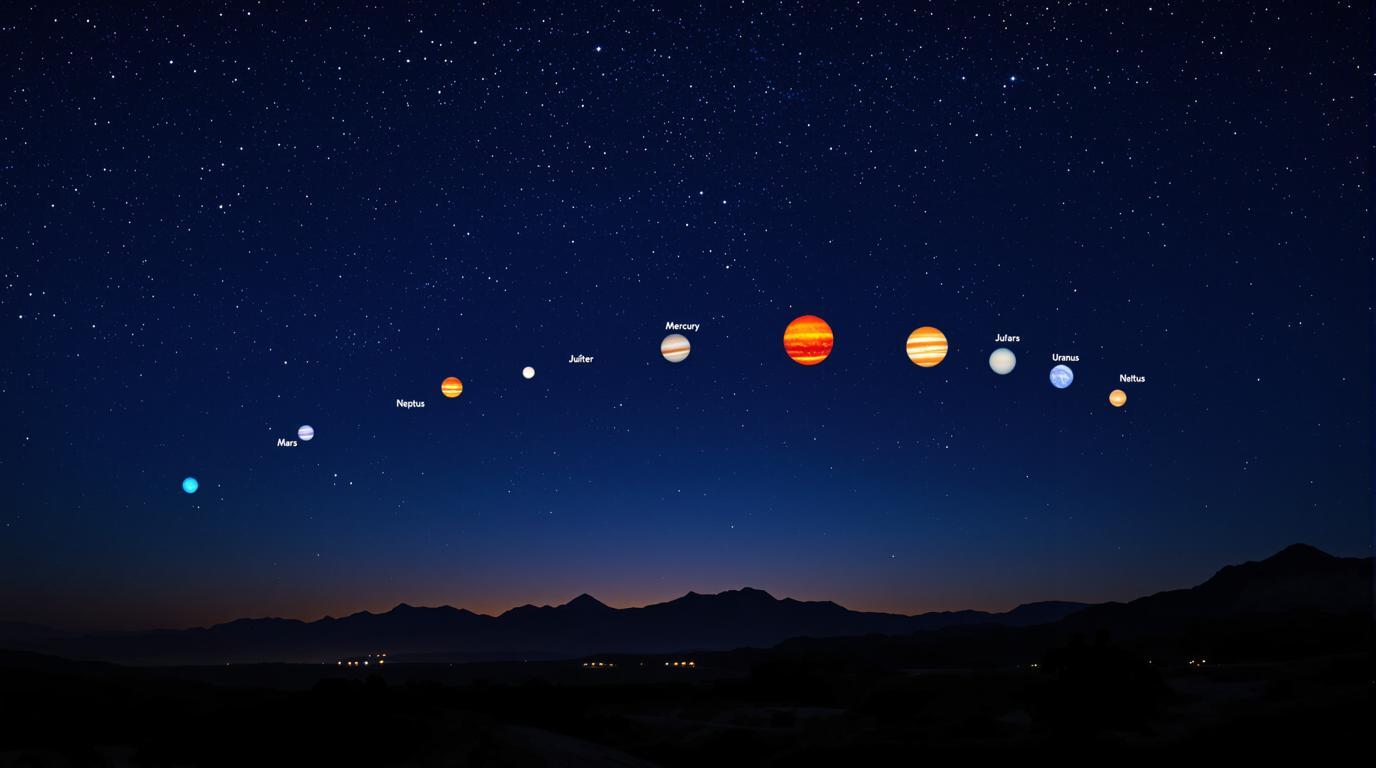A celestial spectacle awaits stargazers on February 28, 2025, as Mercury completes a rare seven-planet alignment that astronomers are calling the “Planetary Parade.” This extraordinary cosmic event will feature all seven planets of our solar system – Mercury, Venus, Mars, Jupiter, Saturn, Uranus, and Neptune – arranged in a magnificent arc across the night sky, something not seen again until 2040.
The astronomical phenomenon that happens once in 15 years
What makes this alignment special is the participation of Mercury, the innermost planet that’s notoriously difficult to spot. As the final piece in this celestial puzzle, Mercury will fall into line with its planetary siblings, creating a spectacular arc visible shortly after sunset.
“This is truly a spectacular opportunity for both professional and amateur astronomers,” explains Dr. Emily Carter, senior astronomer at Stanford University. “Having all seven planets visible simultaneously is something many astronomy enthusiasts wait decades to witness.”
What you’ll actually see in the night sky
Don’t expect a perfect straight line of planets like beads on a string. The alignment follows the ecliptic – the invisible path that traces the plane of our solar system across the sky. Five planets – Mercury, Venus, Mars, Jupiter, and Saturn – will be visible to the naked eye, while Uranus and Neptune require optical assistance.
The planets will appear in a sweeping arc, with Mercury and Saturn positioned low on the western horizon and the others stretching eastward. Venus and Jupiter will shine brightest, serving as excellent reference points for locating their dimmer neighbors.
Where to experience this cosmic marvel
The alignment will be visible globally, but locations with minimal light pollution offer optimal viewing conditions. Dark sky reserves, national parks, and remote areas away from urban centers provide the best experience for witnessing these celestial wonders.
For Americans, Western states like Arizona, Utah, and New Mexico offer exceptional viewing conditions. The McDonald Observatory in Texas and Cherry Springs State Park in Pennsylvania are also prime observation spots with minimal light interference.
When timing is everything: viewing window details
The critical viewing period begins approximately 30 minutes after sunset. Mercury and Saturn will appear first but will set quickly, giving observers a narrow window of about 20-30 minutes to spot them.
“Your biggest challenge will be finding a clear view of the western horizon,” notes amateur astronomer and astrophotography enthusiast James Miller. “Once you’ve spotted Venus and Jupiter – the two brightest objects in the evening sky – you can use them as guideposts to locate the others.”
Essential gear for planetary spotting
While five planets will be visible to the naked eye, having the right equipment enhances the experience. Binoculars (7×50 or 10×50) offer sufficient magnification for seeing Jupiter’s moons and Saturn’s rings. For Uranus and Neptune, a small telescope (4-inch aperture or larger) is necessary.
Astronomy apps like Stellarium or Sky Guide can help locate each planet in real-time. Red-light flashlights preserve night vision while still allowing you to check star charts or adjust equipment.
Capturing the cosmic lineup
Photography enthusiasts can document this rare event with relatively simple equipment. A DSLR camera, wide-angle lens, and stable tripod are the fundamentals. The planets’ journey across the night sky creates perfect conditions for breathtaking landscape astrophotography.
Time-lapse sequences showing the planets’ movement against Earth’s rotation create particularly striking visual records of this rare alignment.
Why this alignment fascinates astronomers
While planetary alignments have no physical effect on Earth, they offer valuable opportunities for educational outreach. The predictable yet rare nature of these events helps illustrate orbital mechanics and the grand clockwork of our solar system.
“These alignments remind us of our place in the cosmos,” says Dr. Maria Johnson of the Adler Planetarium. “They’re a perfect opportunity to experience cosmic wonders that our ancestors have marveled at for millennia.”
Cultural significance across history
Throughout human history, planetary alignments have fascinated civilizations worldwide. Ancient astronomers from Babylonian, Mayan, and Chinese cultures meticulously tracked planetary positions, often attributing spiritual significance to these celestial dances.
Today’s alignment offers a connection to this rich astronomical heritage while showcasing the precision of modern orbital mechanics. Unlike our ancestors who saw divine intervention in these events, we can appreciate them as natural cosmic rhythms that unfold with mathematical certainty.
As Mercury falls into line on February 28, 2025, take a moment to step outside, look up, and witness this grand celestial ballet. In a universe of constant change, these rare moments of cosmic harmony remind us of the dynamic stability that governs our solar neighborhood.
